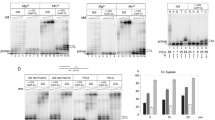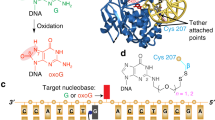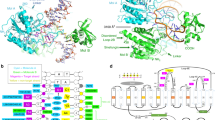Abstract
Base-excision of a self-complementary oligonucleotide with central G:T mismatches by the G:T/U-specific mismatch DNA glycosylase (MUG), generates an unusual DNA structure which is remarkably similar in conformation to an interstrand DNA adduct of the anti-tumor drug cis -diamminedichloroplatinum. The abasic sugars generated by excision of the mismatched thymines are extruded from the double-helix, and the 'widowed' deoxyguanosines rotate so that their N7 and O6 groups protrude into the minor groove of the duplex and restack in an interleaved intercalative geometry, generating a kink in the helix axis.
This is a preview of subscription content, access via your institution
Access options
Subscribe to this journal
Receive 12 print issues and online access
$189.00 per year
only $15.75 per issue
Buy this article
- Purchase on Springer Link
- Instant access to full article PDF
Prices may be subject to local taxes which are calculated during checkout



Similar content being viewed by others
Accession codes
References
Lindahl, T. & Karlström, O. Biochemistry 12, 5151– 5154 (1973).
Lindahl, T. & Nyberg, B. Biochemistry 13, 3405– 3410 (1974).
Nakabeppu, Y., Kondo, H. & Sekiguchi, M. J. Biol. Chem. 259, 3723– 3729 (1984).
Sakumi, K. et al. J. Biol. Chem. 261, 5761– 5766 (1986).
Bjoras, M., Klungland, A., Johansen, R.F. & Seeberg, E. Biochemistry 34, 4577– 4582 (1995).
Nedderman, P. & Jiricny, J. J. Biol. Chem. 268, 21218– 21224 (1993).
Dianov, G. & Lindahl, T. Curr. Biol. 4, 1069– 1076 (1994).
Barrett, T.E. et al. Cell 92, 117– 129 ( 1998).
Gallinari, P. & Jiricny, J. Nature 383, 735– 738 (1996).
Seeberg, E., Eide, L. & Bjørås, M. Trends Biochem. Sci. 20, 391– 397 (1995).
Mol, C.D., Kuo, C.F., Thayer, M.M., Cunningham, R.P. & Tainer, J.A. Nature 374, 381– 386 (1995).
Gorman, M.A. et al. EMBO J. 16, 6548– 6558 ( 1997).
Slupphaug, G. et al. Nature 384, 87– 91 ( 1996).
Cuniasse, P. et al. Nucleic Acids Res. 15, 8003– 8022 (1987).
Kalnik, M.W., Chang, C.N., Johnson, F., Grollman, A.P. & Patel, D.J. Biochemistry 28, 3373– 3383 (1989).
Manoharan, M., Ransom, S.C., Mazumder, A. & Gerlt, J.A. J. Am. Chem. Soc. 110, 1620– 1622 ( 1988).
Goljer, I., Kumar, S. & Bolton, P.H. J. Biol. Chem. 270, 22980– 22987 (1995).
Wang, K.Y., Parker, S.A., Goljer, I. & Bolton, P.H. Biochemistry 36, 11629– 11639 ( 1997).
Huang, H., Zhu, L., Reid, B.R., Drobny, G.P. & Hopkins, P.B. Science 270, 1842– 1845 (1995).
Leslie, A.G.W. Mosflm users guide (MRC-Laboratory of Molecular Biology, Cambridge, UK, 1995).
CCP4. Acta Crystallogr. D 50, 760– 763 (1994).
Navaza, J. Acta Crystallogr. A 50, 157– 163 ( 1994).
Acknowledgements
We thank our colleagues for assistance with data collection and the Ludwig Institute for Cancer Research and the CLRC Daresbury Laboratory for provision of X-ray diffraction facilities. We are particularly grateful to P. Hopkins and S. Thor Sigurdsson for making the coordinates of the cisplatin adduct available to us. This work was supported by the Cancer Research Campaign, as well as by the Schweizerische Krebsliga (J.J.) and the Julius Müller Stiftung (J.J.).
Author information
Authors and Affiliations
Corresponding author
Rights and permissions
About this article
Cite this article
Barrett, T., Savva, R., Barlow, T. et al. Structure of a DNA base-excision product resembling a cisplatin inter-strand adduct. Nat Struct Mol Biol 5, 697–701 (1998). https://doi.org/10.1038/1394
Received:
Accepted:
Issue Date:
DOI: https://doi.org/10.1038/1394



